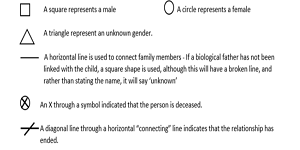
For use with: parent/carers, young people aged 16-18
What is a genogram?
A genogram is a simple tool that can be used to see how a family is made up. It helps you identify who is living in the home with the child and who is in the wider family network.
It is a more formal term for a family tree.
When would you use it?
A genogram can be used when working with children and families. This tool can assist practitioners to help provide information about family members and practitioners to see patterns that maybe contributing to neglect.
Family structures can change overtime, and therefore a genogram should be updated accordingly.
How would you use it?
On a piece of paper, with family members, work together to develop a drawing of their family tree (this is a genogram). You and the family can use which symbols or names are relevant to them, there is not right or wrong way, however there is a recognised format which you can use as detailed below.
Recognised genogram symbols
A genogram uses a number of different symbols to represent gender and family relationships.

Rules to build Genograms
The four rules to build a genogram are:
- The male is always at the left of the family and the female is always at the right of the family.
- In the case of ambiguity, assume a male-female relationship, rather than male-male or female-female relationship.
- A spouse must always be closer to his/her first partner, then the second partner (if any), third partner, and so on...
- The oldest child is always at the left of his/her family, the youngest child is always at the right of the family.
